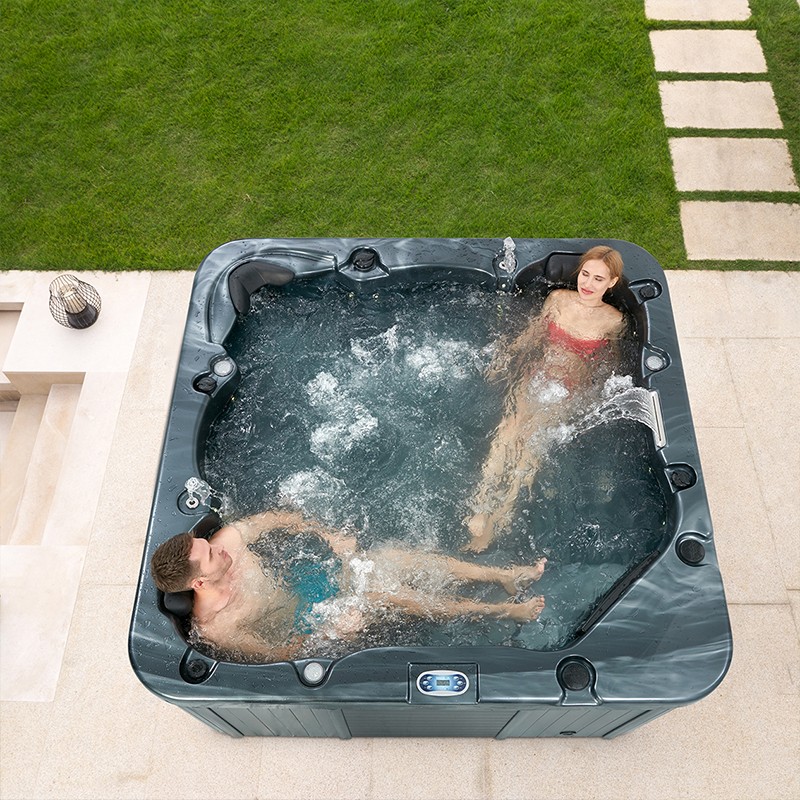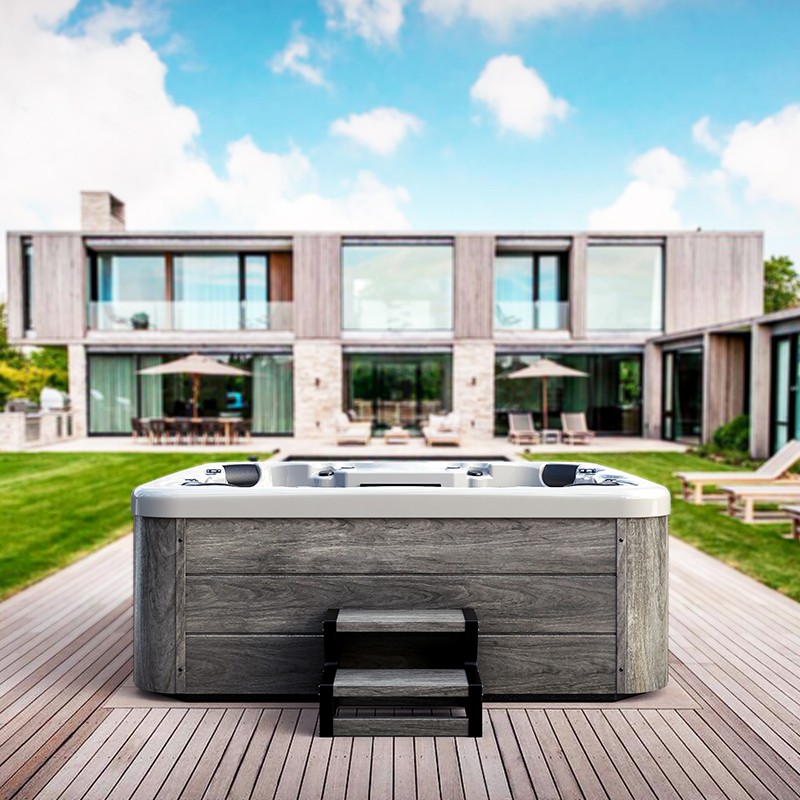
How to winterize your outdoor jacuzzi bathtub?
2025-08-27 15:35With the arrival of cold weather, maintaining your outdoor jacuzzi bathtub becomes even more important. During winter, temperatures drop, and ice, snow, and cold winds can damage the bathtub's structure, electrical system, and water quality. Therefore, thorough preparation is crucial to ensure safe and proper winter operation and avoid equipment failures caused by low temperatures or improper maintenance.
This article will detail how to winterize your outdoor jacuzzi bathtub, covering pre-winter preparations, precautions for use in cold weather, daily maintenance, and potential problems and solutions.

Jacuzzi Bathtub: Why is Winter Preparation Important?
As an outdoor fixture, an outdoor jacuzzi bathtub must withstand a variety of environmental factors. Cold temperatures, ice, snow, and cold winds can all have varying degrees of impact on the bathtub's water system, electrical system, and structural components. Failure to adequately winterize the bathtub can result in damage, leaks, ice formation, or even complete inoperability. Therefore, preparing ahead of time not only extends the life of your bathtub but also avoids unnecessary repair costs and inconvenience.
Jacuzzi bathtub: What are the pre-wintering preparations?
1. Cleaning the bathtub
Before winterizing your bathtub, first thoroughly clean the interior. Cleaning tasks include:
• Clearing the tub: First, use a mesh screen or manually remove floating debris, leaves, and dirt from the tub sump.
• Cleaning the showerhead and water circulation system: Showerheads and water circulation systems that have not been used for a period of time can easily accumulate dirt and scale, affecting water flow and quality. Use a specialized cleaning agent to clean the water circulation pipes and showerheads. It is recommended to use a non-abrasive and system-friendly cleaning product to avoid clogging the pipes or damaging the showerheads.
• Cleaning the water filter: The water filter is a key component in maintaining clean water quality. Remove the water filter and rinse it thoroughly with water to remove impurities.
• Checking the water quality: Change the water in the bathtub to maintain clean water quality. You can add a suitable disinfectant, such as chlorine or bromine, to the water to ensure stable water quality.
Cleaning your spa jacuzzi bathtub ensures it remains free of dirt and limescale during winter use, minimizing damage caused by residual buildup.
2. Draining the Bathtub
During the cold winters in most locations, residual water in your spa jacuzzi bathtub can freeze if not drained promptly, causing cracks or damage to pipes, showerheads, and other components. Draining the water is essential to prevent this problem.
• Drainage System Check: Check all drain pipes for clear, unobstructed drainage and ensure complete drainage. Many spa jacuzzi bathtubs have automatic drain systems, but if not, you'll need to drain the water manually. Use a water pump or aspirator to help ensure complete drainage.
• Drain Check: Ensure the drain is not blocked. Use a pipe cleaner to remove any possible obstructions.
3. Freeze Protection
For spa jacuzzi bathtubs not intended for winter use, the most important precaution is to prevent the pipes and pump from freezing. Here are a few effective ways to prevent freezing:
• Antifreeze: If you don't plan to use your spa jacuzzi bathtub in the winter, consider adding an appropriate amount of antifreeze to the water system. Antifreeze effectively prevents water from freezing in cold temperatures, which can damage the pipes. Choose an antifreeze specifically formulated for spa jacuzzi bathtubs, ensuring it's safe for the pump and piping system.
• Heater Insulation: Some spa jacuzzi bathtubs come with a heater, which can help maintain water temperature during the winter, preventing freezing and cracking. If your spa jacuzzi bathtub supports low-temperature operation, you can set it to winter mode.
• Insulation Cover: Installing a dedicated insulation cover or lid effectively prevents cold air from entering the tub, slowing the rate at which the water temperature drops. Even without a heating system, an insulation cover can provide additional insulation.
4. Disconnect the power and inspect the electrical system
In cold temperatures, the electrical system of a spa jacuzzi bathtub requires special attention. First, ensure the unit is powered off and avoid leaving it powered on for extended periods during the winter. In addition, the following inspections are crucial:
• Check electrical connections and wiring: Check that all electrical connections are secure and that wires are free of wear and tear. Ensure there are no potential short circuits or electrical leakage.
• Protect the electrical system: If your outdoor jacuzzi bathtub has components such as an electric heater or water pump, it is recommended to install waterproof protection and ensure that there is no risk of corrosion to the electrical components due to moisture inside the unit.
5. Cover the bathtub
After draining the water or adding antifreeze, remember to install a cover on the bathtub. A high-quality waterproof cover effectively prevents snow, rain, dust, and other items from entering the outdoor jacuzzi bathtub, minimizing damage.

Outdoor Jacuzzi Bathtub: Cold Weather Precautions
If you plan to use your spa jacuzzi bathtub during the winter, be sure to take the following precautions to ensure the safety of the device and its users:
1. Check the water temperature regularly
Even in an outdoor spa jacuzzi bathtub, the water in the tub needs to maintain a certain temperature. Excessively low water temperatures can cause the unit to malfunction or freeze. Therefore, be sure to check the water temperature regularly when using the bathtub.
2. Maintain clear drainage
During winter use, especially on cold nights, pipes are prone to freezing. It's recommended to regularly check the drainage system to ensure there's no water accumulation or ice.
3. Maintain safety precautions
Due to the low outdoor temperatures, using a spa jacuzzi bathtub can cause discomfort due to the large temperature swings. Therefore, it's crucial to carefully control the water temperature and keep it within a safe range. Also, ensure there's no water accumulation around the bathtub to prevent slipping and other accidents.

Outdoor Jacuzzi Bathtub: Daily Maintenance and Post-Winter Restoration
In addition to winter preparations, restoring and cleaning your spa jacuzzi bathtub after winter is equally important. Here's how:
1. Cleaning the Bathtub
After winter, the first step is to clean your spa jacuzzi bathtub. After draining the water, thoroughly rinse it with warm water and a specialized detergent to remove scale, stains, and bacteria.
2. Check the Water Quality
Before using it again in spring, check the water quality to ensure it's free of bacterial growth. Add an appropriate disinfectant, such as chlorine or bromine, and ensure the water has an appropriate pH level.
3. Equipment Inspection
Inspect all components, including pumps, heaters, and jets, to ensure they haven't been damaged by the cold weather. In particular, check the electrical system and plumbing to ensure they haven't been damaged by freezing or exposure to low temperatures.
4. Resuming Use
After cleaning and inspecting, you can gradually resume use of your spa jacuzzi bathtub. Ensure all systems are functioning properly and that the water temperature is regulated within safety requirements to avoid accidents caused by equipment malfunction.

What certifications do your spa products have?
All of our products meet international standards and are certified with CE, ETL, SAA, ROHS, REACH, and ISO9001. As a reliable supplier and spa manufacturer, we ensure that every unit adheres to strict quality and safety requirements. When you purchase from us, you’re not only investing in high-quality spa equipment, but also in safe and durable branded products trusted by customers across Europe, North America, and beyond. Contact us for official documentation and customized product quotes.
